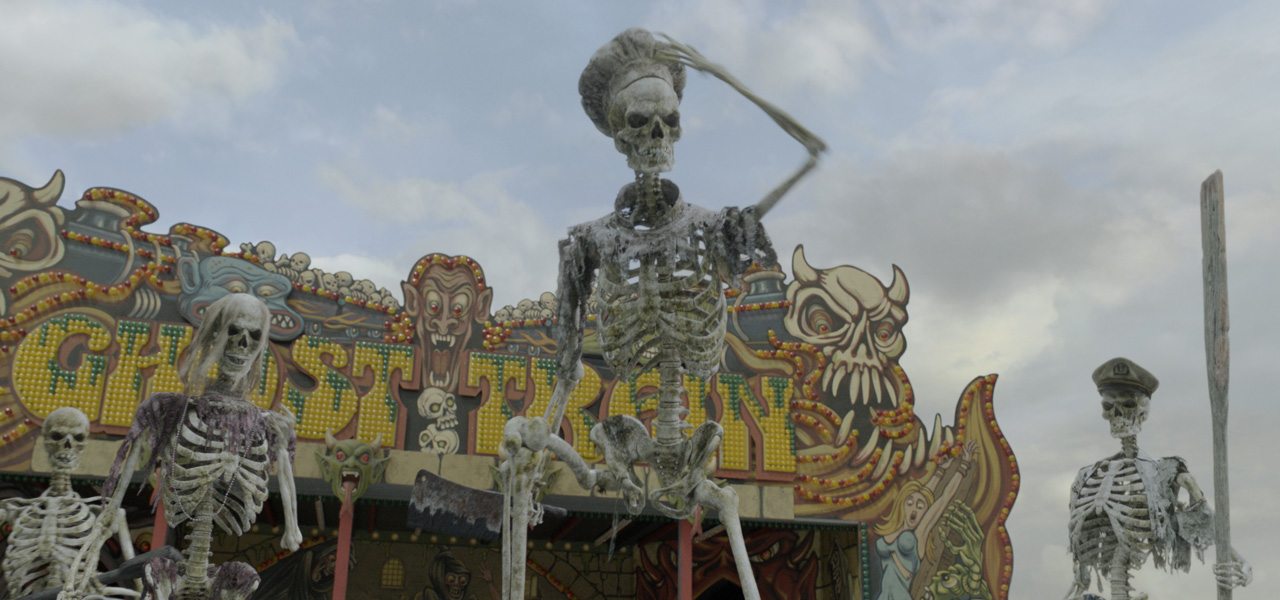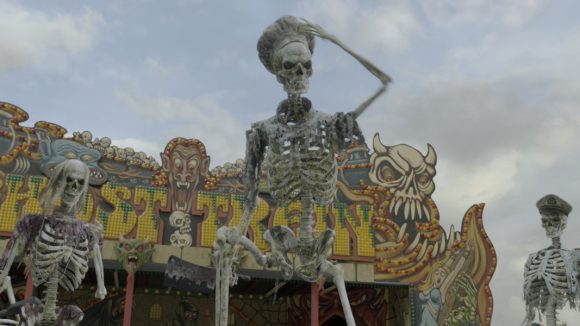

‘Miss Peregrine’s Home for Peculiar Children’ Goes For the Harryhausen Touch
Many animators cite Ray Harryhausen’s skeleton battle in Jason and the Argonauts (1963) as a defining sequence in the history of visual effects. The stop motion work in that scene has indeed inspired several filmmakers to craft their own fantastical fight scenes, and the latest is Tim Burton with his climactic skeleton versus hollowgasts battle in Miss Peregrine’s Home for Peculiar Children.
In the film, the ‘peculiar’ children have raised a sunken cruise ship. The skeletons of the dead passengers and crew—submerged underwater for 70 years—emerge to fight a raft of invisible monsters called hollowgasts at Blackpool Pier amidst the amusement rides there. Visual effects studio Double Negative, under production vfx supervisor Frazer Churchill, brought the skeleton sequence to life, at first attempting to create a stop motion Harryhausen-inspired look, but ultimately switching to a more modern animation style.
Skeleton By Design
Double Negative was charged with designing the look of the skeletons. The skeleton’s clothes were crafted to appear rotten and covered in barnacles, and they fight with whatever props they have found in the dining room or on the decks of the cruise ship.

“It was actually a lot of fun to art direct the barnacle formations and the dis-colorations of the bones,” said Double Negative visual effects supervisor Ollie Rankin, who shared duties with fellow supervisor Andrew Lockley. “We did quite a bit of image research looking for skeletons that had been submerged underwater or buried for a long time.”
Double Negative produced designs that gave unique, and sometimes comical, identifiers to each skeleton. One was a gentleman complete with top hat and cane, for example. Others wore torn garments—even the remnants of a silk dress was part of the digital clothing that had to be simulated.

How To Shoot For Skeletons
Principal photography for the skeleton sequence was filmed at Longcross Studios in the U.K., based on previs by The Third Floor. There were no costumed skeletons or hollowgasts on set, so stand-ins and stunt performers wearing gray tracking suits or bluescreen suits were utilized for the shoot.
Immediately, this presented a huge challenge to Double Negative since the stand-ins (later added as cg skeletons or creatures) would be interacting with extras. The stand-ins also obscured portions of the set, including moving rides, and actors and extras, which Double Negative had to painstakingly paint back into the frame.


The purpose of the gray tracking suits for the skeleton performers was for video reference only, with motion capture shot later. “We took all this reference for all the shots and did some internal motion capture here at Double Negative,” said Double Negative cg supervisor Bruno Baron. “We used our Xsens MVN capture suits to record small clips of motion to mimic the actions. All of that was used as blocking for all the shots. There was also extra mocap done by the production and some additional capture with dancers and stuntmen—all of this was ingested and refined and cleaned up to get what we needed for the movie.”
Animation Experimentation
Once the sequence was shot, Double Negative went through a post-vis phase headed up by animation supervisor Robyn Luckham. (Stephen Enticott was also an animation supervisor for Double Negative on the project). “Production editorial had cut together a rough edit of the sequence and then our animators blocked in the skeletons doing much the same actions as the stand-ins,” said Rankin. “For speed of turnaround, we used the Xsens suit data and put together a library of performances to block in a broad brush approach.”

With the Harryhausen influence in mind, Double Negative had also embarked on a series of animation tests in an attempt to replicate the stop motion look for the skeletons. This began with taking the motion capture performances and doing ‘drop frames,’ that is, animating at 12 frames per second instead of 24 and taking out motion blur.
The initial results were promising in terms of the desired stop motion appeal. “But,” said Rankin, “it did get a little bit strobey in the fast moving action. When somebody was swinging a sword, for instance, you’d really notice that steppiness.”

Various other iterations on the animation then took place, still at this early stage. Ultimately, however, it was decided to abandon the deliberate stop motion look. One major reason was the impact it had when integrated into the scenes. None of the live action crowd or the hollowgasts, or even the camera moves, were filmed with the stop motion look.
“The strobey animation for the skeletons made them look like they weren’t part of the plate, not part of the world,” said Baron. “Also what do you do with garments? How do you simulate when you have missing frames? A lady skeleton had some hair, so what would we have done if we had gone that route? In the end we didn’t use any of that approach.”
The skeletons were finally realized as a combination of motion capture and keyframe animation. They also needed to be rigged so that their bones would scatter when they were killed (for a second time), an effect achieved by animators driving individual bones flying in different directions.
When Skeletons Attack
A major story point in Peculiar Children is that the hollowgasts are invisible to most humans. To help the skeletons with their attack, the children use anything they can to throw at the hollowgasts in order to reveal the creatures. This included an array of items from gummy bears to cotton candy and ketchup that covers the monsters.
That meant that in addition to crafting the cg hollowgasts, Double Negative also had to simulate all these various projectiles and fluids and progressively dress the creatures throughout the sequence. “It was quite tricky to sell that idea,” said Double Negative compositing supervisor Tristan Myles. “There’s one great part of that sequence with a candy floss [cotton candy] machine that is blown onto the hollowgasts and lets you get a good read on them.”


The compositing challenges continued for the entire environment. Although bluescreens had been employed at the Longcross Studios, they only went up so far and Double Negative had to clean up a tree line and background structures, in addition to the complex paint and rotoscoping work for the plates.
Tim Burton’s filmography is rich in the use of stop motion animation and other visual effects, and Miss Peregrine’s Home for Peculiar Children certainly continues the director’s sense of quirkiness, as Rankin observed to Cartoon Brew. “He’s a very aesthetically driven director. That informs his use of visual effects. He wants the cg elements of his movies to have that same kind of organic imperfect off-kilter quality to them.”
